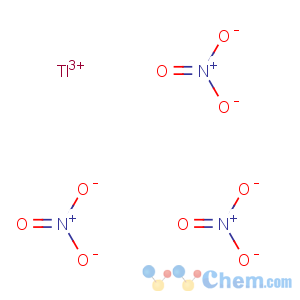Title: Thallium Trinitrate
CAS Registry Number: 13746-98-0
CAS Name: Nitric acid thallium (3+) salt
Synonyms: thallium(III) nitrate
Molecular Formula: TlN3O9
Molecular Weight: 390.40
Percent Composition: Tl 52.35%, N 10.76%, O 36.88%
Line Formula: Tl(NO3)3
Literature References: Oxidizing reagent. Prepn and use for olefin rearrangement: A. McKillop
et al., Tetrahedron Lett. 1970, 5275. Review of early uses:
idem, E. C. Taylor,
Endeavour 35, 88-93 (1976). Phenolic oxidation for isodityrosine functionality: K. Nakamura
et al., Tetrahedron Lett. 42, 6311 (2001); promotion of ring contractions for indans: H. M. C. Ferraz
et al., Tetrahedron 57, 1709 (2001).
Review: idem et al., Synthesis 1999, 2001-2023; T. O. Vieira,
Synlett 2002, 1017-1018.
Properties: Colorless crystals. Readily sol in methanol, dilute mineral acids and mixed sovent systems such as aqueous glyme.
Use: In organic syntheses for a wide variety of oxidations including rearrangement of ketones, olefins, electrophilic cyclization transformations, phenolic oxidative couplings and hydrolysis of dithianes.

